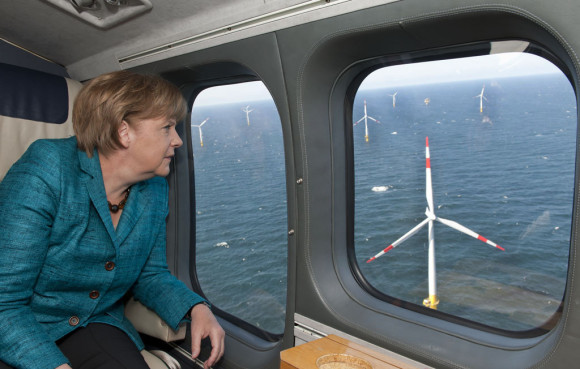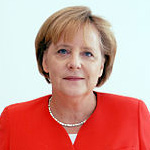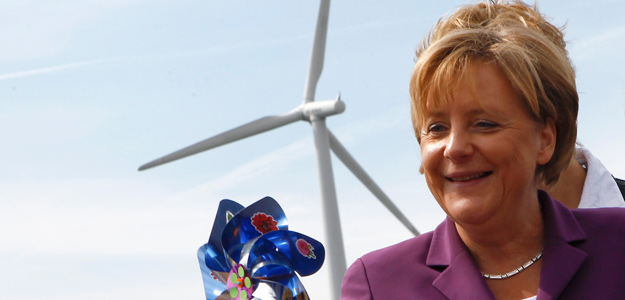Variable wind energy and solar power does not necessarily create a need for ‘back-up generators playing havoc with business models’.
At the end of last month the Economist published an article on Germany’s energy transition to renewables labelling it a “lunatic gamble”. This could not be further from the truth and in this blog we’ll explain why…
The article claimed that German plans to switch to renewable energy are risky, and yet the transition roadmap is based on the recommendations of an expert advisory panel to the German government, the German Advisory Council on the Environment.
German Chancellor Angela Merkel flying over Baltic 1 wind farm.
With a symbolic press of a button German Chancellor Angela Merkel on May 2 inaugurated Germany’s first offshore wind park based in the Baltic Sea.
“This really opens up a new chapter in generating energy in Germany,” said Chancellor Merkel.
The German Government plans to expand the construction of the offshore wind energy facility to take advantage of strong winds sweeping across the Baltic Sea off the coast of northeastern Germany.
By 2030 the new offshore wind park, aptly entitled Baltic 1, will generate 25 gigawatts of electricity, replacing the output some 20 nuclear power plants. This wind energy can thereby supply more than 25 million people with clean energy.
German Chancellor Angela Merkel kicks off a new chapter in wind energy. (© REGIERUNGonline/Bergmann)
According to the German government, electricity from wind parks dotting Germany’s Baltic and North Sea coasts are supposed to cover the lion’s share of the country’s clean energy supply.
Baltic 1 is comprised of 21 wind turbines and is located about 16 kilometers (10 miles) north of the Fischland-Darss-Zingst peninsula.
This body examined the environmental, economic and energy security impacts of a fully renewable energy system and characterised it as ‘climate-friendly, reliable and affordable’.
Angela Merkel, Germany’s chancellor, stands at the entrance to a wind turbine tower at the Wind-projekt Ingenieur- und Projektentwicklungsgesellschaft mbH wind farm in Krempin, near Rostock.
Moreover, a number of companies are exiting nuclear, not just in Germany: in July this year Jeff Immelt, Chief Executive of GE – one of the world’s largest suppliers of nuclear power equipment – stated that nuclear power has become “really hard” to justify in comparison to other energy generation options.
Peter Terium, CEO of RWE, has said his company is exiting from nuclear “with conviction”, and that the “risk this technology presents is not an option in the long run.” Even EDF CEO Vincent de Rivaz, when pressed on the cost of nuclear, was not able to confirm that nuclear will be cheaper than offshore wind by 2020.
Meanwhile the International Energy Agency has said that every dollar invested now in clean energy will save $3 in fossil fuel costs in the future, and that the extra investment made now will be recouped by 2025 at the latest, such is the expected decline in renewable technology costs.
Variable wind and solar power does not necessarily create a need for ‘back-up generators playing havoc with business models’ as the Economist suggests.
When wind turbines and solar plants are geographically widespread, to the extent that Germany’s transition entails, their output becomes far more constant and even easier for the grid to accommodate. Worldwide grid operators rely on wind power and are successfully integrating it in larger amounts. Over a quarter of Denmark’s electricity needs are met by wind power, expected to rise to 50% by 2025, what better example of how a wind-powered system can work than that? Furthermore the cost of generating electricity from wind has declined significantly over the past few years and will continue to decline further with improved efficiency and other expected technological advances. In several cases wind is cheaper than new build coal today.
German Chancellor Angela Merkel
Wind power is in fact more predictable than the ever-changing electricity supply and demand patterns that utility system operators deal with every day, not to mention the dramatic effects of an unexpected shut-down of a large power plant.
Germany’s energy transformation is a “lunatic gamble” only to those absolutely wedded to burning imported fossil fuels or to vastly expensive and potentially hazardous nuclear power generation. If we are to take climate change, energy security, boosting local economies and the need to bring down the costs of energy in the long term seriously, then Germany is a stellar example of the energy transition countries need to make. Of course there are many challenges ahead to achieve this ambitious transformation, but Germany should be applauded not criticised for it.






